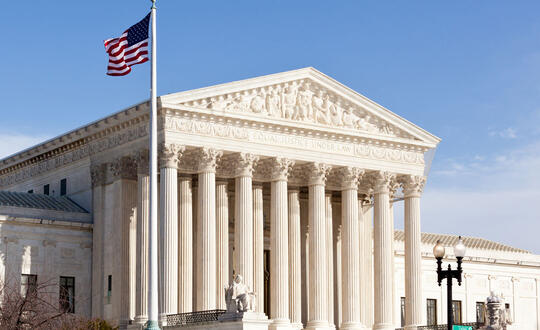U.S. Supreme Court Alert: If you copy an unpatented furniture design, does that help prove that the design was iconic and protected as a trademark?
Oct 31 2023
Furniture manufacturer admits intentionally copying designs, asks Supreme Court, What does copying really say about trademark status of design?
While offering a new design for sale without obtaining a patent often means the design is now in the public domain, copyright and trademark laws could mean otherwise. For example, trademark laws can protect a design that has become “iconic” if that purchasers recognize the design as coming from a single source. So designs like the Eames chair and the Coca-Cola bottle shape are protected by trademark and trade dress law long after any patent protection would have ended. Proving trade dress is difficult, and involves demonstrating sales, advertising and often survey evidence. But courts are split on whether intentional copying can help in the proof that a design has earned trade dress status.
Now, the U.S. Supreme Court is considering weighing in on a dispute involving hand-carved furniture pieces and differences in the standards for determining whether trade-dress has achieved a “secondary meaning” as identifying the source of the goods. Establishing secondary meaning allows a plaintiff (e.g., designer or manufacturer) to bring trademark infringement claims against a competitor who copies the design. In Trendily Furniture, LLC, et al. v. Jason Scott Collection, Inc. the Court is presented with the question: what, if any, probative value is associated with evidence that a competitor intentionally copied a plaintiff’s product design, in determining whether the design has achieved secondary meaning? In practical terms, does the intentional copying by itself demonstrate that the trade-dress achieved secondary meaning or is something more required to prove that a product’s design servers as a source identifier?
Does the intentional copying by itself demonstrate that the trade-dress achieved secondary meaning or is something more required to prove that a product’s design servers as a source identifier?
According to the Petition for Supreme Court review, courts in eleven circuits apply five different standards regarding the appropriate inference from a competitor’s intentional copying. For example, the case was originally heard in the Ninth Circuit where intentional copying itself supports a strong inference of secondary meaning. Under the Ninth Circuit standard—adopted by at least three other circuits—the district court determined (and the appellate court affirmed) plaintiff’s (Jason Scott) products had acquired secondary meaning. Defendant (Trendily) sought Supreme Court review, arguing, among other things, that had the case been heard in the Tenth Circuit a different result would have ensued under that Circuit’s precedent recognizing the many reasons besides deception for copying a product design. The Tenth Circuit (and First and Seventh Circuits) do not view intentional copying alone as evidence of secondary meaning absent proof of intent to confuse consumers and pass off the copy as the plaintiff’s product.
Trendily admitted it intentionally copied Jason Scott’s pieces, originally created by hand-carving furniture from re-claimed teak in a small village in Indonesia and featuring large, heavy-set pieces embellished with detailed wood carvings and metal designs. But Trendily argued the district court erred in making a strong inference of secondary meaning based on intentional copying, because no evidence showed Trendily had intended to confuse customers. The US Court of Appeals for the Ninth Circuit acknowledged that some circuits had imposed an “intent to confuse” requirement but said its own precedent had rejected applying such a requirement for the “intentional copying” factor in a secondary meaning analysis. Trendily argued in the Petition that courts and experts have repudiated the Ninth Circuit’s “flawed” logic for providing undue protection to designs that are properly in the public domain.
The Petition also contrasts other circuits’ approach to weighing intentional copying in determining secondary meaning. In the Third, Eighth, and Eleventh Circuits, secondary meaning may be inferred from intentional copying but no inference is permissible when there is a neutral explanation for the copying. The Fifth Circuit gives intentional copying the same weight as other factors and evidence when determining whether a product has acquired secondary meaning. But in the Fourth Circuit intentional copying does not merely create an inference of secondary meaning but is prima facie evidence of secondary meaning. Trendily highlights that precedent in certain other circuits acknowledges that copying may be for reasons—such as exploiting particularly desirable or intrinsically valuable features—related to effective competition and not confusing consumers.
Interestingly, the Petition cites a Tenth Circuit decision stating in part, “the reality [is] that trade-dress protection is an awkward fit for product design.” However, in Apparatus LLC v. Wayfair LLC, on which we have separately posted, A New York-based design studio successfully obtained a trademark for one of its “most prominent and coveted products”; namely, a frosted glass orb chandelier. The design studio demonstrated to the US Patent & Trademark Office that the chandelier design had acquired secondary meaning as evidenced by its “substantial sales success and unsolicited critical acclaim.” In another post we discussed Hudson Furniture, Inc. v. Mumesan Aydinlatma Dek. San. Tic. Ltd. Sti. (now terminated) in which the plaintiff alleged that the defendant infringed both its patented designs and trade-dress for lighting products with “dramatic, dynamic” designs “recognized and appreciated as Hudson pieces.”
The Supreme Court’s decision in Trendily is likely to impact not only the legal standards surrounding intentional copying in determining secondary meaning but also the competitive landscape, and what competitors may risk, for copying non-patented designs. The Court has not yet agreed to hear the case but on October 17, 2023 requested Jason Scott respond to the Petition despite originally waiving the right to respond. Jason Scott’s response is due November 16, 2023.